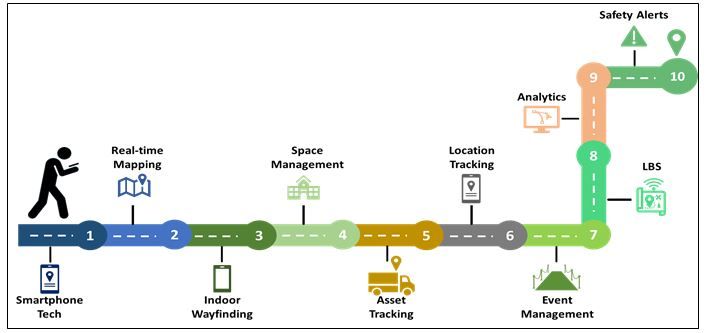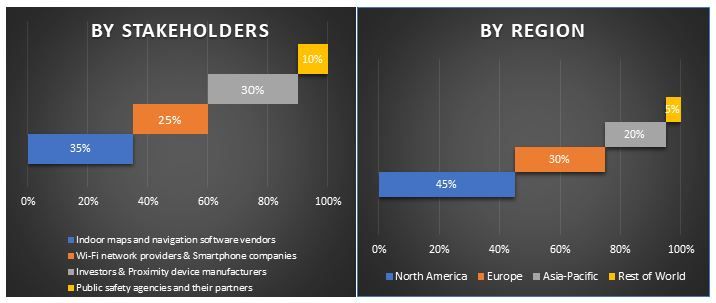- Home
- About Us
- Industry
- Services
- Reading
- Contact Us
Global Indoor Location Market: Current Analysis and Forecast (2020-2026)
Emphasis on Components (Hardware and Services), Model [Hardware Model (Platform as a Service, Desktop/PC as a Service, Infrastructure as a Service, and Device as a Service), Professional Services], Deployment (On-Premises, and Cloud), Enterprize Size (Small & Medium Enterprizes, and Large Enterprizes), Application (Government, Manufacturing, Telecom & IT, Retail, Healthcare, Energy & Utility, Education, and Others), and Region/Country
Global Indoor Location Market generated revenue of US$ 8.9 billion in 2019. The market is expected to grow at a CAGR of 33.47% during the forecast period to reach a market valuation of US$ 68.8 billion by 2026. However, Asia-Pacific is expected to witness the highest CAGR during the forecast period 2020-2026.
The increasing customer expectation, along with measures to control infrastructure cost, is playing a vital role in shaping the future of the indoor location market. Even though the adoption of indoor location technologies is relatively slow due to the lack of research resources, these solutions are expected to grow steadily and are expected to generate strong traction across all the emerging venues – owing to the growing need for “social connectivity,” on a real-time basis.
According to the study conducted by IndoorAtlas 2016, the average percentage of departmental budget spend dedicated to implementing an Indoor Positioning System (IPS) is 2.47% over the next 12 months. In one to two years, 100% of these organizations will be spending on IPS. Spend is set to grow to over 3% of the department budget in the next three to five years. With both IPS usage and spend set to increase over the next two years, it showed the growth in the market as well as within organizations themselves. In just the last few years RFID tags in distribution within the retail supply chain have more than doubled. Tags in the retail space have exploded from 3 billion in 2014 to a projection of nearly 8 billion in 2017. While only a projection, these numbers prove that RFID is being seriously looked at as the omnichannel solution in retail. According to the University of Florida, retailers lose more than US$ 37 billion per year due to shrinkage, or theft. RFID can also serve as an electronic surveillance tool to prevent theft.
American Apparel’s 120 stores using RFID run at 99.8% inventory accuracy and shrinkage has been cut by 55%, on average. Wi-Fi-based indoor positioning for determining accurate wireless indoor location information has become crucial in meeting increasing demands for location-based services by leveraging the Internet of Things (IoT) and ubiquitous connectivity.
Benefits of Indoor Navigation
Cisco Systems, Apple, Broadcom, Ericsson, Google, Microsoft, Qualcomm, STMicroelectronics, SAP SE and Zebra Technologies are some of the prominent players operating in the global indoor location market. Several M&A’s along with partnerships have been undertaken by these players to facilitate customers with hi-tech and innovative products.
Insights Presented in the Report
“Amongst type, software tools segment holds the major share”
Based on type, the market is fragmented into technology, software tools and services. Software tools dominated the market in 2019 and are expected to maintain its dominance during the forecast period. Among the software tools, Location analytics holds the maximum market as it is a method of market intelligence, extracting information from location-based data.
“Amongst deployment type, cloud dominated the market in 2019”
The deployment type segment is further divided into the cloud and on-premises. Cloud dominated the market in 2019 and is expected to maintain its dominance during the forecast period. The adoption of cloud-based solutions on the indoor location market is expected to grow, mainly due to their advantages such as easy trading data maintenance, cost-effectiveness, scalability, and efficient management. However, on-premises deployment is anticipated to witness the highest CAGR during the forecast period (2020-2026).
“Amongst applications, sales and marketing organizations are expected to dominate the market during the analyzed period”
The application segment is bifurcated into applications include in sales and marketing optimization, customer experience management, remote monitoring, inventory management, predictive asset analytics, risk management, emergency response management, and others (augmented reality and supply chain optimization). In 2019, Sales and Marketing Optimization holds maximum market share followed by Customer Experience Management. The sales and marketing collaboratively working toward the common goal of profitably increasing revenue and customer excellence through shared processes, resources, and metrics.
“Amongst industry verticals, retail dominated the market in 2019”
Based on the industry verticals, the market is segmented into transportation, retail, entertainment, hospitality, public building, and others (manufacturing, healthcare, enterprises). In 2019, retail accounted for 17.6% of market revenue share and is expected to dominate the market during the forecast period as it guides the shoppers to the quickest route to reach a store of their choice. The positioning system makes it easy to find a store and gives authorities a chance to develop a better traffic flow management system.
“North America represents one of the largest markets of Indoor Location market”
For a better understanding of the market dynamics of the indoor location market, a detailed analysis was conducted for different regions across the globe including North America (US, Canada, Rest of North America), Europe (Germany, UK, France, Italy, Spain, Rest of Europe), Asia-Pacific (China, Japan, India, South Korea, Australia and Rest of Asia-Pacific), Latin America and MEA has been conducted. North America dominated the market and generated revenue of US$ 2.61 billion in 2019 owing to the availability of advanced connectivity wireless technology and technologies such as 3D based indoor positioning system. However, due to the adoption of an indoor location by users and different industry verticals in the region, Asia-Pacific is expected to have the highest growth rate during the forecast period.
Reasons to buy this report:
- The study includes market sizing and forecasting analysis validated by authenticated key industry experts
- The report presents a quick review of overall industry performance at one glance
- The report covers an in-depth analysis of prominent industry peers with a primary focus on key business financials, product portfolio, expansion strategies, and recent developments
- Detailed examination of drivers, restraints, key trends, and opportunities prevailing in the industry
- The study comprehensively covers the market across different segments
- Deep dive regional level analysis of the industry
Customization Options:
The Indoor Location Market can further be customized as per the requirement or any other market segment. Besides this, UMI understands that you may have your own business needs, hence feel free to connect with us to get a report that completely suits your requirements.
Table of Content
Analyzing the historical market, estimation of the current market, and forecasting the future market of the Global Indoor Location Market were the three major steps undertaken to create and analyze the adoption of indoor locations across various industry verticals in major regions globally. Exhaustive secondary research was conducted to collect the historical market numbers and estimate the current market size. Secondly, to validate these insights, numerous findings and assumptions were taken into consideration. Moreover, exhaustive primary interviews were also conducted, with industry experts across the value chain of the indoor location sector. Post assumption and validation of market numbers through primary interviews, we employed a top-down approach to forecast the complete market size. Thereafter, market breakdown and data triangulation methods were adopted to estimate and analyze the market size of segments and sub-segments the industry pertains to. Detailed methodology is explained below:
Analysis of Historical Market Size
Step 1: In-Depth Study of Secondary Sources:
Detail secondary study was conducted to obtain the historical market size of the Indoor Location through company internal sources such as annual report & financial statements, performance presentations, press releases, etc., and external sources including journals, news & articles, government publications, competitor publications, sector reports, third-party database, and other credible publications.
Step 2: Market Segmentation:
After obtaining the historical market size of the Indoor Location market, we conducted a detailed secondary analysis to gather historical market insights and share for different segments & sub-segments for major regions. Major segments included in the report as type, deployment, application, and industry verticals. Further country-level analyses were conducted to evaluate the overall adoption of the Indoor Location in that region.
Step 3: Factor Analysis:
After acquiring the historical market size of different segments and sub-segments, we conducted a detailed factor analysis to estimate the current market size of Indoor Location. Further, we conducted factor analysis using dependent and independent variables such as increasing adoption of connected devices, the inefficiency of GPS technology, increasing internet penetration and advancement in technology. A thorough analysis was conducted for demand and supply-side scenario considering top partnerships, merger and acquisition, business expansion, and product launches in the Indoor Location industry across the globe.
Current Market Size Estimate & Forecast
Current Market Sizing: Based on actionable insights from the above 3 steps, we arrived at the current market size, key players in the Indoor Location market, and market shares of the segments. All the required percentage shares split, and market breakdowns were determined using the above-mentioned secondary approach and were verified through primary interviews.
Estimation & Forecasting: For market estimation and forecast, weights were assigned to different factors including drivers & trends, restraints, and opportunities available for the stakeholders. After analyzing these factors, relevant forecasting techniques i.e. top-down approach was applied to arrive at the market forecast about 2026 for different segments and subsegments across the major markets globally. The research methodology adopted to estimate the market size encompasses:
- The industry’s market size, in terms of value (US$) and the adoption rate of Indoor Location across the major markets
- All percentage shares, splits, and breakdowns of market segments and sub-segments
- Key players in the Indoor Location market in terms of services offered. Also, the growth strategies adopted by these players to compete in the fast-growing market
Market Size and Share Validation
Primary Research: In-depth interviews were conducted with the Key Opinion Leaders (KOLs) including Top Level Executives (CXO/VPs, Sales Head, Marketing Head, Operational Head, and Regional Head, Country Head, etc.) across major regions. Primary research findings were then summarized, and statistical analysis was performed to prove the stated hypothesis. Inputs from primary research were consolidated with secondary findings, hence turning information into actionable insights.
Split of Primary Participants in Different Regions
Market Engineering
Data triangulation technique was employed to complete the overall market estimation and to arrive at precise statistical numbers of each segment and sub-segment of the Indoor Location market. Data was split into several segments & sub-segments post studying various parameters and trends in the areas of major type, deployment, applications, and industry verticals of the Indoor Location market.
The main objective of the Indoor Location Market Study
The current & future market trends of Indoor Location were pinpointed in the study. Investors can gain strategic insights to base their discretion for investments from the qualitative and quantitative analysis performed in the study. Current and future market trends were determined the overall attractiveness of the market at a regional level, providing a platform for the industrial participant to exploit the untapped market to benefit as a first-mover advantage. Other quantitative goals of the studies include:
- Analyze the current and forecast market size of Indoor Location in terms of value (US$). Also, analyze the current and forecast market size of different segments and sub-segments
- Segments in the study include areas of type, deployment, application, and industry verticals
- Defined analysis of the regulatory framework for the Indoor Location industry
- Analyze the value chain involved with the presence of various intermediaries, along with analyzing customer and competitor behaviors of the industry
- Analyze the current and forecast market size of the Indoor Location for the major regions
- Major regions studied in the report include North America (the U.S., and Canada), Europe (Germany, France, Italy, Spain, and United Kingdom), Asia-Pacific (China, Japan, India, South Korea, and Australia), MEA, and Latin America
- Company profiles of the Indoor Location market players and the growth strategies adopted by them to sustain in the fast-growing market
Deep dive regional level analysis of the industry
Related Reports
Customers who bought this item also bought













